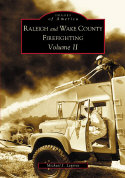Available at area Barnes & Noble, Borders, Waldenbooks, Book-A-Million, local independent booksellers, gift shops, and museum stores, www.amazon.com, www.barnesandnoble.com, and www.arcadiapublishing.com. Or contact Arcadia's toll-free sales number at 1-888-313-BOOK (2665) IntroductionThis second collection of historical firefighting images concentrates on the years 1940 to 1990, five formative decades for fire protection in North Carolina's capital county. During this time, the Raleigh Fire Department quadrupled in size, smaller municipal departments modernized, and rural departments organized. Raleigh's fire department was firmly established by 1940 with five stations and 56 full-time firemen operating five engines and two truck companies. They were 27 years old as a "paid department" and decades past their horse-drawn days. Outside of Raleigh, many of Wake County's smaller towns had purchased fire equipment by 1940. These ranged from hand-drawn hose reels to early-model pumpers. They had fire chiefs with slim salaries and volunteers to respond from their homes and businesses. (For their service, the firemen received a couple dollars per call or exemptions on certain taxes.) By the late 1940s and early 1950s, these towns-- Apex, Cary, Fuquay Springs, Wake Forest, Wendell, and Zebulon-- each had a brand-new, fully-equipped fire engine with a full complement of volunteer firefighters. Wake Forest even had a second fire company, organized in 1942 to protect colored residents. Beginning in the 1950s, formal fire protection became available outside of Raleigh and those small-town centers. A rural fire department program enabled any group of citizens to organize a volunteer department. The Office of Civil Defense offered funding, equipment, and a county-wide radio network. Lower insurance rates were an added incentive. And so they formed-- inside, outside, and entirely removed from Wake's municipalities. Residents of Garner, Knightdale, Morrisville, and Rolesville formed their town's first fire companies in the 1950's. In the suburbs of Raleigh, the New Hope, Six Forks Road, and Western Boulevard fire departments formed in the late 1950s; the Durham Highway and Fairgrounds fire departments forming in the early 1960s. (Who were these volunteers? Six Forks Road members in 1958 included a grocer, barber, detective, telephone man, lawyer, school teacher, florist, mail carrier, heating contractor, two mechanics, a Civil Defense official, and several State workers.) ...continued in the book! |
